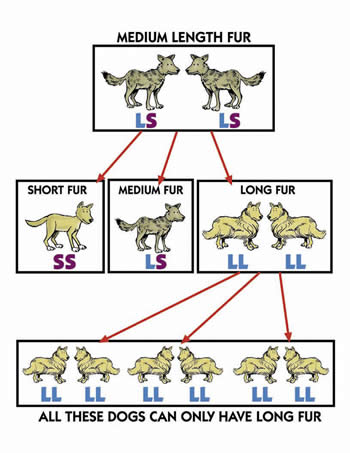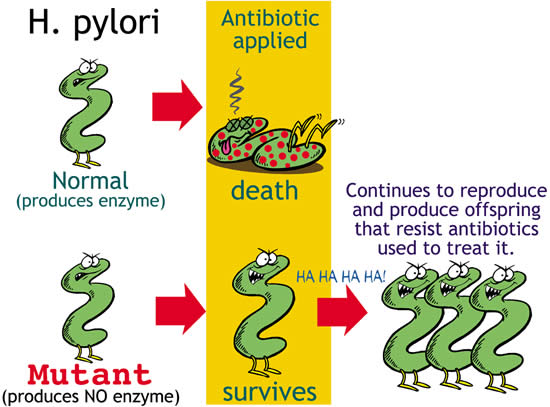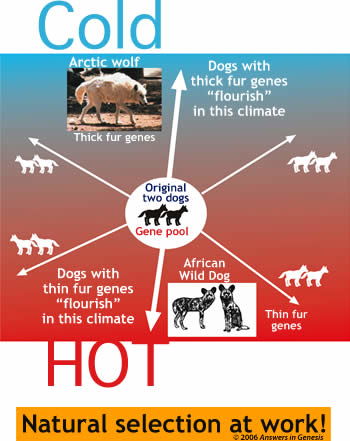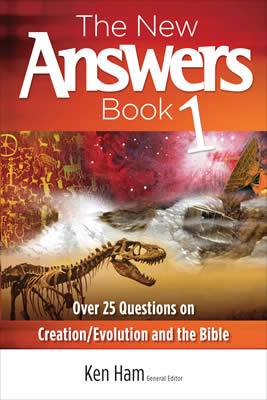
Chapter 22
Is Natural Selection the Same Thing as Evolution?
Natural selection is an observable process that is often purported to be the underlying mechanism of unobservable molecules-to-man evolution.
Let’s listen in on a hypothetical conversation between a biblical creationist (C) and an evolutionist (E) as they discuss some recent scientific news headlines:
E: Have you heard about the research findings regarding mouse evolution?
C: Are you referring to the finding of coat color change in beach mice?
E: Yes, isn’t it a wonderful example of evolution in action?
C: No, I think it’s a good example of natural selection in action, which is merely selecting information that already exists.
E: Well, what about antibiotic resistance in bacteria? Don’t you think that’s a good example of evolution occurring right before our eyes?
C: No, you seem to be confusing the terms “evolution” and “natural selection.”
E: But natural selection is the primary mechanism that drives evolution.
C: Natural selection doesn’t drive molecules-to-man evolution; you are giving natural selection a power that it does not have—one that can supposedly add new information to the genome, as molecules-to-man evolution requires. But natural selection simply can’t do that because it works with information that already exists.
Natural Selection is an observable process that is often purported to be the underlying mechanism of unobservable molecules-to-man evolution. The concepts are indeed different, though some mistakenly interchange the two. So let’s take a closer look. There are two major questions to answer:
- How do biblical creationists rightly view the observable phenomenon of natural selection?
- Could this process cause the increase in genetic information necessary for molecules-to-man evolution?
What Is Natural Selection?
Below are some definitions evolutionists use to define “natural selection.” The problem biblical creationists have with these definitions lies mostly in their misapplication, as noted by the bolded phrases.
Evolutionary change based on the differential reproductive success of individuals within a species.1
The process by which genetic traits are passed on to each successive generation. Over time, natural selection helps species become better adaptedto their environment. Also known as “survival of the fittest,” natural selection is the driving force behind the process of evolution.2
The process in nature by which, according to Darwin’s theory of evolution, only the organisms best adapted to their environment tend to survive and transmit their genetic characters in increasing numbers to succeeding generations while those less adapted tend to be eliminated (also see evolution).3
From a creationist perspective natural selection is a process whereby organisms possessing specific characteristics (reflective of their genetic makeup) survive better than others in a given environment or under a given selective pressure (i.e., antibiotic resistance in bacteria). Those with certain characteristics live, and those without them diminish in number or die.
The problem for evolutionists is that natural selection is nondirectional—should the environment change or the selective pressure be removed, those organisms with previously selected for characteristics are typically less able to deal with the changes and may be selected against because their genetic information has decreased—more on this later. Evolution of the molecules-to-man variety, requires directional change. Thus, the term “evolution” cannot be rightly used in the context of describing what natural selection can accomplish.
What Is Evolution?
This term has many definitions just as “natural selection” does. Much of the term’s definition depends on the context in which the word “evolution” is used. Below are some recent notable definitions of evolution (note the bold phrases).
Unfolding in time of a predictable or prepackaged sequence in an inherently, or at least directional manner.4
The theory that all life forms are descended from one or several common ancestors that were present on early earth, three to four billion years ago.5
The “Big Idea” [referring to evolution] is that living things (species) are related to one another through common ancestry from earlier forms that differed from them. Darwin called this “descent with modification,” and it is still the best definition of evolution we can use, especially with members of the general public and with young learners.6
All of these definitions give the same basic idea that evolution is directional in producing all the life-forms on earth today from one or several ancestral life-forms billions of years ago. The last definition is especially intriguing because it indicates that an ambiguous definition of evolution should be used with the public and with children. Most creationists would agree partially with the idea of “descent with modification” in that species we have today look different from the original kinds that God created (i.e., the great variety of dogs we have now compared to the original created dog kind). The advantage with using such a broad definition for evolution is that it can include any and all supporting models of evolution (such as traditional Darwinism, neo-Darwinism, punctuated equilibrium, etc.) and can spark the least amount of controversy in the public eye.
Historical Background on the Discovery of Natural Selection
Many people give credit to Charles Darwin for formulating the theory of natural selection as described in his book On the Origin of Species. Few realize that Darwin only popularized the idea and actually borrowed it from several other people, especially a creationist by the name of Edward Blyth. Blyth published several articles describing the process of natural selection in Magazine of Natural History between 1835 and 1837—a full 22 years before Darwin published his book. It is also known that Darwin had copies of these magazines and that parts of On The Origin of Species are nearly verbatim from Blyth’s articles.7
Blyth, however, differed from Darwin in his starting assumptions. Blyth believed in God as the Creator, rather than the blind forces of nature. He believed that God created original kinds, that all modern species descended from those kinds, and that natural selection acted by conserving rather than originating. Blyth also believed that man was a separate creation from animals. This is especially important since humans are made in the image of God, an attribute that cannot be applied to animals (Genesis 1:27). Blyth seemed to view natural selection as a mechanism designed directly or indirectly by God to allow His creation to survive in a post-Fall, post-Flood world. This is very different from Darwin’s view. Darwin wrote, “What a book a devil’s chaplain might write on the clumsy, wasteful, blundering low and horridly cruel works of nature.”8
Is Natural Selection Biblical?
It is important to see natural selection as a mechanism that God used to allow organisms to deal with their changing environments in a sin-cursed world.
It is important to see natural selection as a mechanism that God used to allow organisms to deal with their changing environments in a sin-cursed world—especially after the Flood. God foreknew that the Fall and the Flood were going to happen, and so He designed organisms with a great amount of genetic diversity that could be selected for or against, resulting in certain characteristics depending on the circumstances. Whether this information was initially part of the original design during Creation Week before the Fall or was added, in part, at the Fall (as a part of the punishment of man and the world by God),9 we can’t be certain. Regardless, the great variety of information in the original created kinds can only be attributed to an intelligence—God.
In addition, natural selection works to preserve the genetic viability of the original created kinds by removing from the population those with severely deleterious/lethal characteristics. Natural selection, acting on genetic information, is the primary mechanism that explains how organisms could have survived after the Fall and Flood when the world changed drastically from God’s original creation.
Let me take a moment to clarify an important theological point so there is no confusion. Death entered the world as the result of sin. Death, therefore, is in the world as a punishment for man’s disobedience to God, and it should remind us that the world is sin-cursed and needs a Savior. Death is not a good thing but is called an enemy (1 Corinthians 15:26).
But recall that God, in His infinite wisdom, can make good come out of anything, and death is no exception. God is able to make good come out of even death itself. Natural selection, though fueled by death, helps the population by getting rid of genetic defects, etc. In the same way, without death Christ wouldn’t have conquered it and been glorified in His Resurrection.
So what can natural selection accomplish and not accomplish? The table on the next page displays some of the main points.
| Natural Selection Can | Natural Selection Cannot |
|---|---|
| 1. Decrease genetic information. | 1. Increase or provide new genetic information. |
| 2. Allow organisms to survive better in a given environment. | 2. Allow organisms to evolve from molecules to man. |
| 3. Act as a “selector.” | 3. Act as an “originator.” |
| 4. Support creation’s “orchard” of life. | 4. Support evolutionary “tree” of life. |

The evolutionary tree, which postulates that all today’s species are descended from one common ancestor (which itself evolved from nonliving chemicals).

The creationist orchard,10 which shows that diversity has occurred within the original Genesis kinds over time.11
Natural Selection and Dogs
Let’s illustrate the possibilities and limitations of natural selection using the example of varying fur length of dogs (designed variation).
There are many different dog species—some with long fur and some with short fur. The original dog kind, most likely resembling today’s wolf, had several variants of the gene for fur length. L will be the variant of the gene representing long fur, and S will be the variant of the gene representing short fur.

The original dog kind most likely would have been a mixture of the genes specifying fur length, including both L and S. Because of this makeup, they also most likely had the characteristic of medium fur length. When the original kind (LS dogs) mated, their genetic variability could be seen in their offspring in three ways—LL for long fur, LS for medium fur, and SS for short fur.
If two long-fur dogs then mated, the only possible outcome for the offspring is LL, long fur. As can be seen in the example below, the long-fur dogs have lost the S gene variant and are thus not capable of producing dogs with short fur or medium fur. This loss may be an advantage if these long-fur dogs live in an area with cold temperatures. The long-fur dogs would then be naturally selected for, as they would survive better in the given environment. Eventually, the majority of this area’s dog population would have long fur.
However, the loss of the S variant could be a disadvantage to the long-fur dogs if the climate became warmer or if the dogs moved to a warmer climate. Because of their decreased genetic variety (no S gene), they would be unable to produce dogs with short fur, which would be needed to survive better in a warm environment. In this situation, the long-fur dogs would be naturally selected against and die.
When the two dogs representing the dog kind came off Noah’s Ark and began spreading across the globe, we can see how the variation favored some animals and not others.
Using the points from the table for what natural selection can accomplish (seen above), it can be seen that:
- Through natural selection, genetic information (variety) was lost.
- The long-fur dogs survive better in a cold environment; they are less able to survive in a warm environment and vice versa.
- A particular characteristic in the dog population was selected for.
- Dogs are still dogs since the variation is within the boundaries of “kind.”
Natural selection of designed variation within the dog kind is not an example of evolution because it does not lead to the formation of a different kind of animal such as a horse, bear, or human. Instead, it is evidence of God’s grace in supplying for His creation in the altered environments of a post-Fall, post-Flood world.
Natural Selection and Bacteria
Another example of natural selection is that of antibiotic resistance in bacteria. Such natural selection is commonly portrayed as evolution in action, but in this case, natural selection works in conjunction with mutation rather than designed variation.
Antibiotics are natural products produced by fungi and bacteria, and the antibiotics we use today are typically derivatives of those. Because of this relationship, it is not surprising that some bacteria would have resistance to certain antibiotics; they must do so to be competitive in their environment. In fact, if you took a sample of soil from outside your home, you would find antibiotic-resistant bacteria.
A bacterium can gain resistance through two primary ways:
- By losing genetic information, and
- By using a design feature built in to swap DNA—a bacterium gains resistance from another bacterium that has resistance.
Let’s take a look at the first. Antibiotics usually bind a protein in the bacterium and prevent it from functioning properly, killing the bacteria. Antibiotic-resistant bacteria have a mutation in the DNA which codes for that protein. The antibiotic then cannot bind to the protein produced from the mutated DNA, and thus, the bacteria live. Although the bacteria can survive well in an environment with antibiotics, it has come at a cost. If the antibiotic-resistant bacteria are grown with the nonmutant bacteria in an environment without antibiotics, the nonmutant bacteria will live and the mutant bacteria will die. This is because the mutant bacteria produce a mutant protein that does not allow them to compete with other bacteria for necessary nutrients. The “supergerms” are really “superwimps.”12
Let’s clarify this some by looking at the bacteria Helicobacter pylori. Antibiotic-resistant H. pylori have a mutation that results in the loss of information to produce an enzyme. This enzyme normally converts an antibiotic to a poison, which causes death. But when the antibiotics are applied to the mutant H. pylori, these bacteria can live while the normal bacteria are killed. So by natural selection the ones that lost information survive and pass this trait along to their offspring.

Now let’s take a look at the second method. A bacterium can get antibiotic resistance by gaining the aforementioned mutated DNA from another bacterium. Unlike you and me, bacteria can swap DNA. It is important to note that this is still not considered a gain of genetic information since the information already exists and that while the mutated DNA may be new to a particular bacterium, it is not new overall.
Using the points from the table for what natural selection can accomplish, it can be seen that:
- Through mutation, genetic information was lost.
- The antibiotic resistant bacteria only survive well in an environment with antibiotics; they are less able to survive in the wild. (It is important to keep in mind that the gain of antibiotic resistance is not an example of a beneficial mutation but rather a beneficial outcome of a mutation in a given environment. These types of mutations are rare in other organisms as offspring are more limited in number; therefore, there is a greater need to preserve genetic integrity.)
- A particular mutation in a bacterial population was selected for.
- H. pylori is still H. pylori. No evolution has taken place to change it into something else—it’s still the same bacteria with some variation.
Antibiotic resistance in bacteria, rather than being an example of evolution in action, is another example of natural selection seen properly from a biblical/creationist perspective.
Speciation—A Possible Outcome of Natural Selection

A species can be defined as a population of organisms produced by a parent population that has changed so significantly that it can no longer interbreed with the parent population. Using the example of dogs, it is possible that long-fur dogs might change sufficiently (other changes besides fur might also be selected for living in cold environments) to the point that they can no longer mate with short-fur or medium-fur dogs.
Although evolutionists claim that speciation takes long periods of time (millions of years), they are often amazed at how fast species can be observed to form today. Speciation has been observed to occur in as little as a few years as seen in guppies, lizards, fruit flies, mosquitoes, finches, and mice.13 This observation does not come as a surprise to creationists as all species alive in the past and today would have had to be produced in fewer than 6,000 years from the original created kinds. In fact, such processes (and perhaps other genetic factors) would have occurred rapidly after the Flood, producing variation within each kind. Such effects are largely responsible for generating the tremendous diversity seen in the living world.14
Speciation has never been observed to form an organism of a different kind, such as a dog species producing a cat. Speciation works only within a kind. Evolution requires natural selection and speciation to give rise to new kinds from a former kind (e.g., dinosaurs evolving into birds). Speciation, however, leads to a loss of information, not the gain of information required by evolution. Thus, speciation as a possible outcome of natural selection cannot be used as a mechanism for molecules-to-man evolution.
Conclusion
When discussing natural selection as a possible mechanism for evolution, it is important to define terms. Evolutionists and biblical creationists view these terms differently, but it comes down to how we interpret the evidence in light of our foundation. Do we view natural selection using God’s Word as our foundation, or do we use man’s ideas as our foundation?
The creationist view of natural selection is supported biblically and scientifically. Natural selection is a God-ordained process that allows organisms to survive in a post-Fall, post-Flood world. It is an observable reality that occurs in the present and takes advantage of the variations within the kinds and works to preserve the genetic viability of the kinds.
Simply put, the changes that are observed today show variation within the created kind—a horizontal change. For a molecules-to-man evolutionary model, there must be a change from one kind into another—a vertical change. This is simply not observed. We have never seen a bacterium like H. pylori give rise to something like a dog. Instead, we simply observe variations within each created kind.
Evolution requires an increase in information that results in a directional movement from molecules to man. Natural selection cannot be a mechanism for evolution because it results in a decrease in information and is not directional. Speciation may occur as a result of natural selection, but it only occurs within a kind. Therefore, it is also not a mechanism for evolution but rather supports the biblical model.
Natural selection cannot be the driving force for molecules-to-man evolution when it does not have that power, nor should it be confused with molecules-to-man evolution. It is an observable phenomenon that preserves genetic viability and allows limited variation within a kind—nothing more, nothing less. It is a great confirmation of the Bible’s history.
The New Answers Book 1
The New Answers Book 1 is packed with biblical answers to over 25 of the most important questions on creation,evolution, and the Bible.
Read Online Buy BookFootnotes
- Michael A.Park, Introducing Anthropology: An Integrated Approach, 2nd Ed., glossary, highered.mcgraw-hill.com/sites/0072549238/student_view0/glossary.html, 2002.
- National Geographic’s strange days on planet earth, glossary, www.pbs.org/strangedays/glossary/N.html.
- Dinosaurs—glossary of terms, www.internal.schools.net.au/edu/lesson_ideas/dinosaurs/glossary.html.
- S.J. Gould, What does the dreaded “E” word mean, anyway? Natural History 109(1): 28–44, 2000.
- D. O’Leary, By Design or by Chance? Castle Quay, Kitchener, Ontario, Canada, 7, 2004.
- Eugenie C. Scott, Creation or evolution? https://web.archive.org/web/20050406235737/www.ncseweb.org/resources/articles/6261_creation_or_evolution__1_9_2001.asp.
- J. Foard, The Darwin papers, “Edward Blyth and natural selection,” www.thedarwinpapers.com.
- Letter from Charles Darwin to Joseph Hooker, Darwin Archives, Cambridge University, July 13, 1856.
- See chapter 21 in this book.
- Dr. Kurt Wise developed the “orchard” analogy in the early 90s.
- Creationists often refer to each kind as a baramin, from Hebrew bara = create and min = kind.
- C. Wieland, Superbugs not super after all, Creation 20(1):10–13, June–August 1992.
- D. Catchpoole and C. Wieland, Speedy species surprise, Creation 23(2):13–15, March 2001.
- C. Wieland, Darwin’s finches, Creation 14(3):22–23, June 1992.

Answers in Genesis is an apologetics ministry, dedicated to helping Christians defend their faith and proclaim the good news of Jesus Christ.
- Customer Service 800.778.3390
- Available Monday–Friday | 9 AM–5 PM ET
- © 2025 Answers in Genesis

